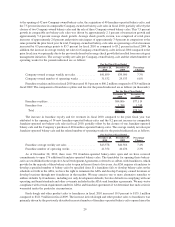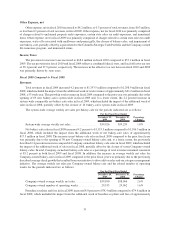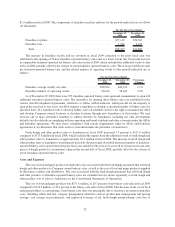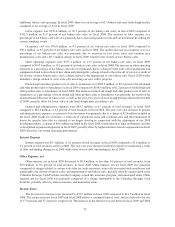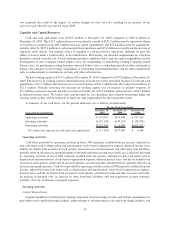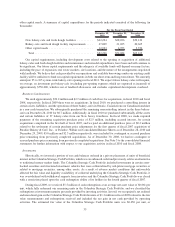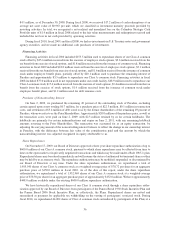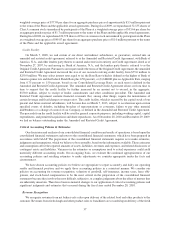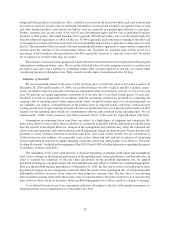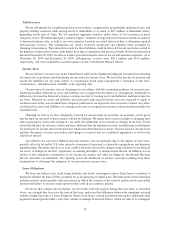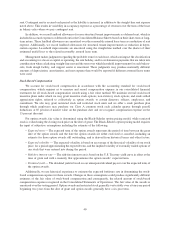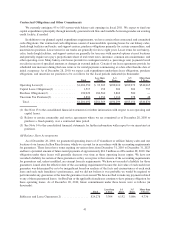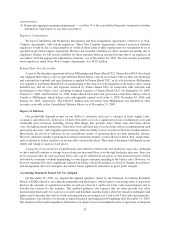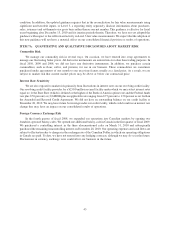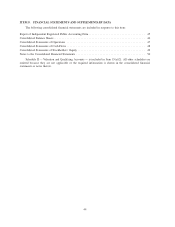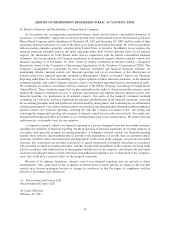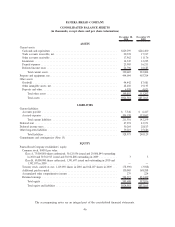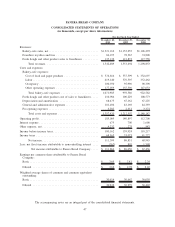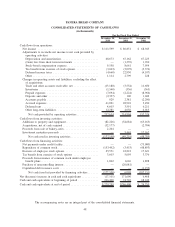Panera Bread 2010 Annual Report Download - page 45
Download and view the complete annual report
Please find page 45 of the 2010 Panera Bread annual report below. You can navigate through the pages in the report by either clicking on the pages listed below, or by using the keyword search tool below to find specific information within the annual report.dough and other products to franchisees. Also, a liability is recorded in the period in which a gift card is issued and
proceeds are received. As gift cards are redeemed, this liability is reduced and revenue is recognized. Sales of soup
and other branded products sold outside our bakery-cafes are generally recognized upon delivery to customers.
Further, franchise fees are the result of the sale of area development rights and the sale of individual franchise
locations to third parties. The initial franchise fee is generally $35,000 per bakery-cafe to be developed under the
Area Development Agreement, or ADA. Of this fee, $5,000 is generally paid at the time of signing of the ADA and
is recognized as revenue when it is received as it is non-refundable and we have to perform no other service to earn
this fee. The remainder of the fee is paid at the time an individual franchise agreement is signed and is recognized as
revenue upon the opening of the corresponding bakery-cafe. Royalties are generally paid weekly based on a
percentage of net franchisee sales specified in each ADA (generally 4 percent to 5 percent of net sales). Royalties
are recognized as revenue when they are earned.
We maintain a customer loyalty program in which customers earn rewards based on registration in the program
and purchases within our bakery-cafes. We record the full retail value of loyalty program rewards as a reduction of
net bakery-cafe sales and a liability is established within other accrued expenses as rewards are earned while
considering historical redemption rates. Fully earned rewards expire if unredeemed after 60 days.
Valuation of Goodwill
We record goodwill related to the excess of the purchase price over the fair value of net assets acquired. At
December 28, 2010 and December 29, 2009, our goodwill balance was $94.4 million and $87.5 million, respec-
tively. Goodwill is subject to periodic evaluation for impairment when circumstances warrant, or at least once per
year. We perform our annual impairment assessment as of the first day of our fiscal fourth quarter of each year.
Goodwill is tested for impairment in accordance with the accounting standard for goodwill by comparing the
carrying value of reporting units to their estimated fair values. As quoted market prices for our reporting units are
not available, fair value is estimated based on the present value of expected future cash flows, with forecasted
average growth rates of approximately four percent and average discount rates of 10 percent used in the fiscal 2010
analysis for the reporting units, which are commensurate with the risks involved in the reporting units. We use
current results, trends, future prospects, and other economic factors as the basis for expected future cash flows.
Assumptions in estimating future cash flows are subject to a high degree of judgment and complexity. We
make every effort to forecast these future cash flows as accurately as possible with the information available at the
time the forecast is developed. However, changes in the assumptions and estimates may affect the estimated fair
value of our reporting units, and could result in goodwill impairment charges in future periods. Factors that have the
potential to create variances between forecasted cash flows and actual results include but are not limited to
(i) fluctuations in sales volumes; (ii) commodity costs, such as wheat and fuel; and (iii) acceptance of our pricing
actions undertaken in response to rapidly changing commodity prices and other product costs. Refer to “Forward-
Looking Statements” included in the beginning of this 2010 Form 10-K for further information regarding the impact
of estimates of future cash flows.
The calculation of fair value could increase or decrease depending on changes in the inputs and assumptions
used, such as changes in the financial performance of the reporting units, future growth rates, and discount rates. In
order to evaluate the sensitivity of the fair value calculations on the goodwill impairment test, we applied
hypothetical changes to our projected growth rates and discount rates which we believe are considered appropriate.
Based on the goodwill analysis performed as of September 29, 2010, the first day of our fiscal fourth quarter, these
hypothetical changes in our assumptions would not affect the results of the impairment test, as all reporting units
individually still have an excess of fair value over their respective carrying value. The fair value of our reporting
units exceeded carrying value under the present value of expected future cash flows model for all of our reporting
units, however there can be no assurance future goodwill impairment tests will not result in a charge to earnings.
As we did not become aware of any impairment indicators subsequent to the date of the annual assessment, we
determined there was no impairment as of December 28, 2010.
38



